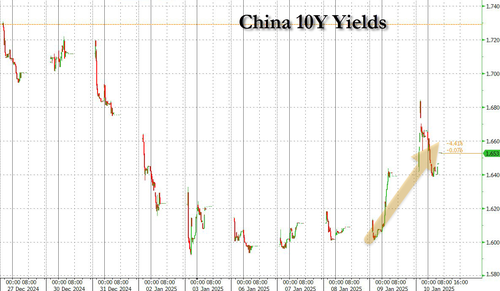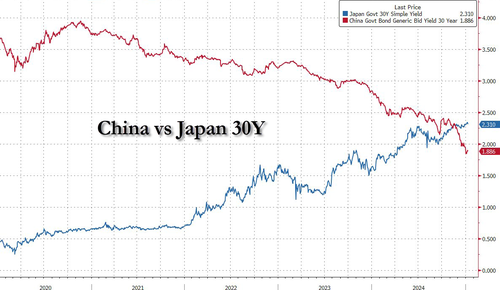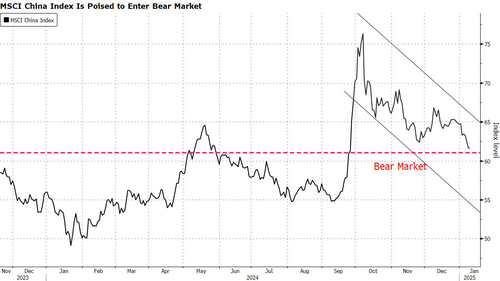China Suspends QE To Reverse Crashing Yields, As Stocks Enter Bear Market
One is free to call the bond purchases by the Chinese central bank “QE” or “not QE” (similar to the charade the Fed tried to pass back in 2019 in the US), but the end result is the same: the central bank is buying bonds, injecting liquidity in the system and depressing the currency in the process while effectively deflating the economy. Or, as the case may be, it no longer is now that China’s roving gangs of momentum-cashing marauders have frontran the central bank so hard, bond yields plunged to record lows and forced the PBOC to “temporarily” suspend treasury bond purchases on Friday, briefly lifting yields and spurring speculation it is stepping up defense of the yuan currency which has been sliding since late September, or before the election of Donald Trump as U.S. president. The move breaks with five months of buying and coincides with a brutal selloff in global bond markets, suggesting the People’s Bank of China is also trying to ensure yields at home rise in tandem, or at least stop falling, analysts quoted by Reuters said.
Yields jumped following the announcement, though benchmark 10-year rates were slightly lower by evening. China’s 10-year treasury yield initially rose four basis points but was last down by just over half a basis point to 1.619%. The yuan rose slightly though it was last trading flat at 7.3326 per dollar, around a 16-month low.
The PBOC cited a shortage of bonds in the market as the reason it was halting the purchases, which were part of its operations to ease monetary settings and boost economic activity.
The policy shift and the market’s caurious response points to the juggling act PBOC is attempting as it seeks to revive economic growth by keeping cash conditions easy, while also trying to douse a runaway bond rally reinforcing the country’s deflationary collapse while simultaneously also stabilizing the currency amid political and economic uncertainty.
“It has indicated a willingness to loosen policy further … however, (yuan) weakness due to the strong dollar and widening differential with U.S. rates will complicate the PBOC’s position,” analysts at Commerzbank said in a note.
The central bank said in a statement it would resume bond buying via open market operations “at a proper time depending on supply and demand in the government bond market”.
“One of the key reasons for the depreciation of the yuan is the widened yield gap between China and the U.S., so the central bank is sending a signal to the market that the yield rate is unlikely to fall further,” Ken Cheung, chief Asian FX strategist at Mizuho Bank, although the yield rate is falling not so much because the PBOC is desperately trying to control it, but because China is now caught in a vicious deflationary debt trap, the same kind that pulled Japan’s yields to 0 for decades.
And speaking of the ZIRPing bond yield black hole that is Japan, its 30Y bond yields are now about 50bps above those of China!
While its stock markets have imploded, bond prices in China have been on a decade-long rally – one that kicked into a higher gear two years ago as property sector woes and weakness in the stock market triggered a flood of funds flowing into bank deposits and the debt market, while starting a period of unprecedented deflation.
This week the market defied a global selloff, rallying on irresistible demand for safe assets and investors’ bets on further rate cuts in the world’s second-biggest economy.
Meanwhile, the PBOC had warned for months about bubble risks as long-dated yields hit successive record lows, though at the same time authorities have foreshadowed further easing.
Not surprisingly, amid this massive monetary stimulus (just don’t call it QE”) the Chinese yuan has fallen nearly 5% since September, both due to worries that Trump’s threats of fresh trade tariffs will heap more pressure on the struggling Chinese economy, but mostly because the realization that even the PBOC is now rapidly replacing its currency with physical gold, as reported here.
Huang Xuefeng, research director at Shanghai Anfang Private Fund Co in Shanghai, said he expects the downtrend in bond yields to persist as “the market continues to grapple with an asset famine situation” where there’s a shortage of good investment opportunities.
Of course, this being China, the paradoxes never end, and on Friday, Financial News, a PBOC publication, quoted an economist as saying that the market should avoid excessive expectations on monetary policy easing. Which is ridiculous since absent further monetary easing, China’s deflationary job will become an all out sprint.
And while the PBOC is scrambling to contain the buying frenzy in China’s bonds, the country’s stocks have no such problem and China’s shares fell overnight, pushing the MSCI China Index down as much as 1.1% on Friday, taking its decline from an Oct. 7 close to around 20%. The CSI 300 Index of onshore Chinese shares was down 0.9% and has lost nearly 5% in the new year.
China’s stocks have started 2025 on a weak note – more than 4,500 stocks listed in Shanghai, Shenzhen and Beijing fell on Friday, a far cry from the brief stimulus-driven euphoria from last September – as investors brace for higher tariffs that may prolong China’s economic slowdown. The US blacklisted Tencent Holdings and CATL (or Contemporary Amperex Technology Co) this week for alleged links to the Chinese military, while the Biden administration is mulling another round of curbs on the export of artificial intelligence chips. The moves have rekindled fears that tensions will only worsen under incoming President Trump.
“It reflects the numerous uncertainties going on with weakening macro numbers, Trump inauguration, currency pressure due to US dollar strength, and a lull in stimulus until Two-Sessions,” said Xin-Yao Ng, a Singapore-based investment director at abrdn Plc. “I think fast money might stay away in the first quarter and wait for things to be clearer, especially Trump’s tariffs.”
A stunning rally in Chinese shares late last year lost steam as investors’ hopes of a more forceful fiscal stimulus didn’t bear fruit. While authorities have continued to roll out fresh support measures, they have been piecemeal in nature and far short of market expectations.
Pessimism about an economy mired in a housing crisis and deflationary pressures has continued. China’s consumer inflation weakened further toward zero in December, decelerating for a fourth straight month in a setback for the government’s bid to drive up demand. In their latest efforts, authorities unveiled plans to subsidize more consumer products and boost funding for industrial equipment upgrades. The central bank also reiterated a pledge to lower interest rates and the reserve requirement ratio for banks “at an appropriate time” to promote growth.
There’s a lack of positive catalysts for the market given a likely lull in major policy announcements until China’s so-called Two Sessions annual legislative meeting in March.
Finally, while the market is desperate for Beijing to unleash a torrent of trillions in fiscal stimulus – similar to what China did in the 2008 crisis – the problem is that the country is so overlevered (its debt/GDP ratio was north of 350% at last check) that it has been forced to resort to such laughable “stimulus programs” as subsidizing consumers who trade in old appliances such as air conditioners and washing machines as policymakers strive to counter weak consumption in the world’s second-largest economy.
The policy initiative, taken right out of Biden’s “cash for clunkers” playbook, which was launched last year to encourage purchases of cars and home appliances, will now also include microwaves, rice cookers, dishwashers and water purifiers as well as smartphones and tablets costing less than Rmb6,000.
Needless to say, pulling demand from the future to today with a “20% off” deal will not reverse the country’s deflationary vortex.
Tyler Durden
Fri, 01/10/2025 – 14:00




